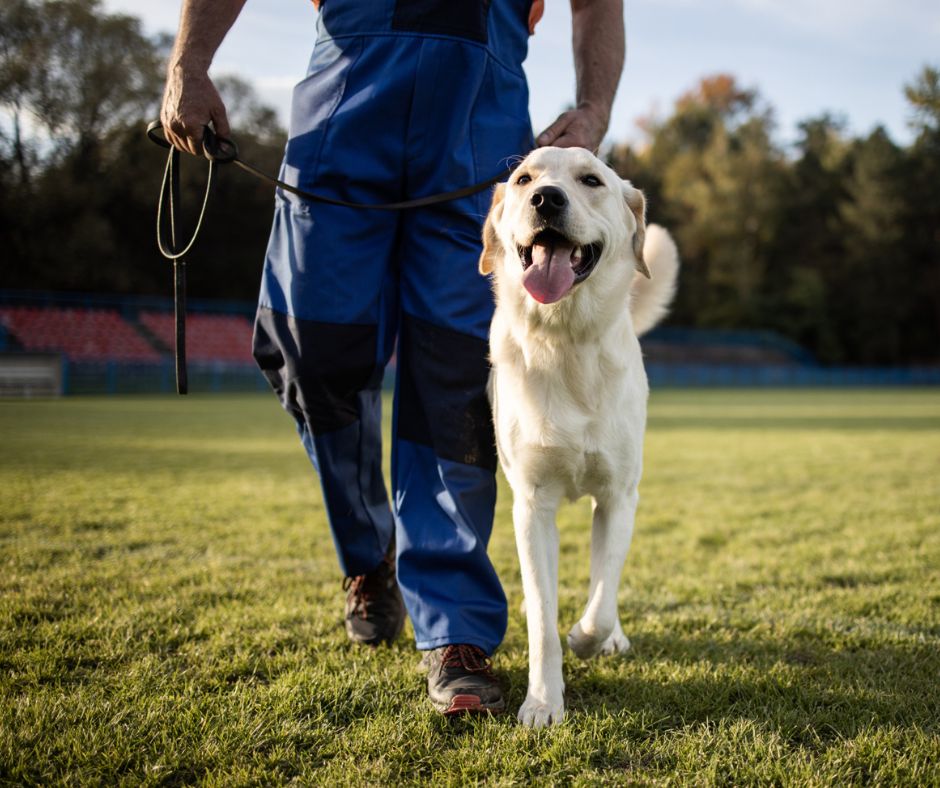Have you ever wondered what it takes to transform a playful pup into a well-behaved companion or to help a once-troubled dog thrive? Behind every success story is a skilled dog trainer whose knowledge and patience made all the difference.
If you’re passionate about dogs and considering a career in training, you might ask yourself, how long does it take to become a dog trainer?
The answer isn’t one-size-fits-all—it depends on your goals, dedication, and the path you choose. The process requires commitment and time, from learning the fundamentals of dog behavior to gaining hands-on experience and earning certifications, but don’t let that intimidate you.
Stratford Career Institute can help you get started with the introductory course, Canine Specialist program. This flexible, at-home course provides a basic foundation in dog behavior and training principles, helping you decide if dog training is right for you.
This guide will walk you through many things you need to know, breaking down each step so you can decide whether to pursue this exciting and rewarding career.
How Long Does It Take to Complete Training as a Dog Trainer?
The time required to train as a dog trainer mainly depends on the type of program you choose and your level of commitment. Some programs are self-paced, allowing you to progress as quickly or slowly as you need, while others follow a set schedule.
Online programs tend to be shorter and more flexible, often taking a few weeks or months to complete. On the other hand, in-person courses with hands-on components may take closer to a year.
If you pursue advanced training in specialized areas, such as service dog training or behavior modification, you may need to dedicate additional time to these more complex skills.
Ultimately, completing your training as a dog trainer is not just about attending a course; it’s about building a deep understanding of dog behavior and learning effective techniques for working with dogs and their owners.
Breaking Down the Process: Education, Hands-On Experience, and Certification
The journey to becoming a dog trainer involves several key steps. Each stage contributes to your development and can prepare you to work effectively with dogs and their owners. Here’s a detailed look at what’s involved.
1. Education and Research
Before enrolling in a formal program, many aspiring dog trainers learn the basics of dog training and behavior. Depending on your research, determining the route you wish to take may take a few weeks.
Learn what it means to be a dog trainer, including the job’s responsibilities, challenges, and rewards. Then, you should research various educational options, comparing curriculum, format, and cost.
2. Formal Training Programs
Once you’ve chosen a training program, you can begin to acquire the knowledge and skills needed to succeed as a dog trainer. These programs typically cover:
- Canine behavior—understanding how dogs think, communicate, and respond to various stimuli;
- Training techniques—learning practical methods to teach dogs obedience, tricks, and desired behaviors; and
- Client interaction—developing the ability to work effectively with dog owners and provide guidance on maintaining training at home.
While online courses are convenient and flexible, in-person programs often include hands-on components, such as working with dogs in a training facility. The choice between these formats depends on your learning style and schedule.
3. Gaining Hands-on Experience
Hands-on experience is an essential part of becoming a skilled dog trainer. This stage can take anywhere from 6 to 12 months and involves working directly with dogs in various settings. Some common ways to gain experience include:
- Volunteering,
- Apprenticeships, and
- Practice with friends and family.
This phase will not only hone your skills but could also help you build knowledge that can be useful when seeking clients or applying for certification.
4. Earning Certification
Certification is not always required to work as a dog trainer, but it can significantly enhance your credibility and career prospects. Organizations like the Certification Council for Professional Dog Trainers (CCPDT) offer certifications that demonstrate expertise.
How long does it take to become a certified dog trainer? It depends on the organization and its requirements. If you want to build a career as a dog trainer, having a certification can help differentiate you from other dog trainers.
Begin Your Journey at Stratford Career Institute
Whether you are looking to work with pet dogs, specialize in advanced training, or even open your own business, the skills you develop as a trainer can lead to a rewarding and versatile career.
Becoming a dog trainer can be incredibly rewarding if you’re passionate about working with dogs and committed to putting in the time and effort.
Ready to take the first step? Begin exploring programs that align with your goals and enroll in Stratford Career Institute’s Canine Specialist program.


